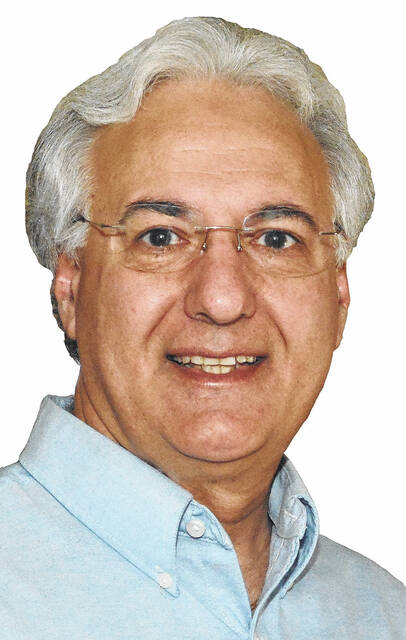It looks like we finally have a rain-free weekend, and I hope everyone has enjoyed the three-day holiday.
I had the privilege of covering the Battle of Wyoming ceremony on July 4th morning. If you’ve never been to the event, you should try. It’s a big part of not only our area’s history, but of the country.
I’ve covered the ceremony plenty of times in the past, but this year was great because of the fantastic weather. It was sunny, a bit cool for the 10 a.m. start and the humidity was low.
I believe this year was one of the most attended. Cars lined Wyoming Avenue all the way down to the Midway Shopping Center. I’m not sure how many chairs are set up for the event, but there had to be 200 to 300 under the tent and surrounding it.
Wyoming Monument Association President Marcella Star and Frank E. P. Conyngham, Wyoming Commemorative Association president, and all of the organizations involved with the Battle of Wyoming ceremony and keeping this part of history alive do a great job keeping the event going from year to year.
There are plenty of others involved to keep the Battle of Wyoming
If you ever wanted to know what the inside of the Wyoming Monument looks like, every Fourth of July they open it up for the public to go in. Honestly, there is nothing to see inside, but an empty interior as you gaze up 60 feet to the top.
If you are lucky enough, someone from the 24th Connecticut Militia Regiment, a re-enactment group, will give you a history lesson on the monument.
Made of sandstone, the monument itself, as I mentioned, is exactly 63 feet tall and took ten years to construct from 1833 to 1843. At one point, 20 feet of the base was started before they ran out of money. Construction resumed in 1841 to completion.
When I was a child, my dad would tell us there were bones inside the monument. So, much for an old wives tale, but dad was partially right.
As the story goes, those massacred at the Battle of Wyoming were buried in a mass grave. The bones were later exhumed, stored, then reinterred in a vault below the monument, so yes; the grounds at the Wyoming Monument are hallowed and should be regarded with the highest respect.
We all drive by the monument and never think twice about it other than there is a large obelisk parked right off Route 11, but it is, in fact, a cemetery where nearly 300 American militiamen were killed with many of their bodies scalped and mutilated — hence the term massacre.
The monument is also on the National Registry of Historic Places since 2002, and this year’s Battle of Wyoming commemoration was the 147th, and it marked the 247th anniversary of the battle itself, which took place on July 3, 1778 — just two years after the birth of our nation.
The battle was a huge victory for the Native Americans and British Loyalists.
Speaking of Native Americans, the forces were made up of Iroquois Warriors, especially from the Seneca and Mohawk nations.
Our local history is fascinating and it’s something we take for granted. I think history teachers around Wyoming Valley should take a good portion of a quarter and teach about our own part of American history. Hopefully some already do.
We all know the United States has a state named Wyoming, but many do not realize it was actually named after our Wyoming Valley.
The name Wyoming comes from the Native American language of Munsee Lenape, which means “at the big river flat.” It refers to the flat lands along the river from Exeter to Wyoming. Much of that land became farmland for the rich soil.
In 1809, Scottish poet Thomas Campbell wrote, “Gertrude of Wyoming” about the Wyoming Valley and the massacre.
In the mid-1800s, a western territory took the name from the poem when it was being organized.
Wyoming Territory was established in 1968 and was granted statehood in 1890 making Wyoming the 44th U.S. state.
I think that’s so impressive and as we know, the name Wyoming is everywhere in the valley from the valley itself, to the avenue we drive on, to the two school districts — Wyoming Area and Wyoming Valley West. And let’s not forget the Wyoming Valley Mall.
How many places or sites can you name with the word Wyoming in it?
So, I hope that after reading this week’s column, you might have a different perspective on the Wyoming Monument and its meaning and respect as a burial ground for so many lives.
Now that we are in the heart of summer, July will fly by as usual. Enjoy temperatures in the 80s and 90s because they are fleeting. In January and February, we will long for these days.
Get out and enjoy the splendor and beauty of Northeastern Pennsylvania with hundreds of lakes and trails and state parks and of course, the Susquehanna River.
As for me, I’m enjoying the sunshine and heat, and when inside, I get to watch Wimbledon, one of my favorite tennis tournaments to watch.
Whatever you do or choose, make it a great week.
Quote of the Week
“The tragedy of Wyoming was not merely a military defeat, but a reminder that even a just cause can be overwhelmed by brutal force if unprepared.” —Allan Nevins, American historian, on the Battle of Wyoming
Thought of the Week
“No other event of the Revolution caused more horror among the American people than the Massacre of Wyoming.” —Minerva G. Bennett, historian
Bumper Sticker
“Those who deny freedom to others deserve it not for themselves.” —Abraham Lincoln




